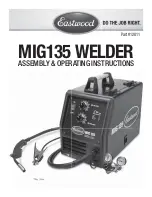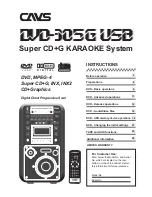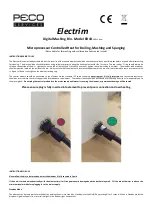
16
Front Panel Description and Explanation:
1.
Protective Cover.
The unit features a protective
hinged cover. This cover should be down when-
ever welding is actively taking place or when the
welder is stored for an extended period of time.
2.
Volts Display.
The readout displays MIG volts
and Stick volts. The unit voltage will vary as the
voltage knob is increased or decreased in MIG
mode during setup. In stick mode the volts are
not adjustable, but the unit will display the open
circuit voltage (OCV). While welding, the volts
will display dynamically and show actual output.
3.
Arc Force Control.
Varies the current rise time
during MIG welding. It also varies the amp re-
sponse and arc feel in Stick operation.
For MIG:
This affects the actual point where the current
potential has risen sufficiently to burn back the
wire after pinching off and depositing in the pud-
dle. The point at which it has burned back is
considered the
“
pinch point
”.
This is where the
wire will begin to once again melt and transfer.
To put it in more practical terms, the user will see
that the wire is sticking out longer or shorter
from the MIG torch before it burns away, de-
pending upon the exact setting. This controls
spatter, penetration and bead profile. When the
arc force knob is rotated from one extreme to
the other, the operator will observe that the arc
is more stiff at one end or more fluid at the other
end. Bead profile changes will occur as well. A
stiffer arc will produce a deep but narrow profile.
A fluid arc will produce a wider, shallower weld,
usually with an improved bead appearance and
less spatter. Arc force control is also known as
inductance control, slope or wave form control
(MIG). By changing the level of inductance the
user can fine tune the arc performance so the
welder responds in a manner that the user is ac-
customed to with other brands of machines. The
arc sound will also change as the arc force is ad-
justed, going from a pitched whine to a frying
sizzle. All MIGs, regardless of brand, without an
adjustable arc force, do have some fixed level of
inductance, though not all are set at the same
level. A person can either adjust the arc force to
have a familiar feel, or to improve arc behavior
whenever welding position or condition change.
For Stick:
The control is used to vary the auto-
matic arc response. While stick welding, the arc
force counter acts the drop in voltage experi-
enced when the arc length is too short and falls
below 20 volts. The amps are automatically in-
creased to offset the loss of voltage to maintain
the welding arc and prevent the rod from going
out and sticking. It can also be used to help in-
crease penetration. Too much arc force in stick
can or MIG can create a violent arc, so be careful
about setting too much. For MIG a good starting
point is around 7. For Sick start at 3. Gradually
make half increment changes up or down to fine
tune the arc. Giant swings in settings will make
other parameters harder to dial in properly as
the arc force can greatly affect the feel of the
welder.
4.
Amp/Wire Speed Display.
This displays wire
speed while the unit is not welding and actual
output amps while welding in MIG mode. Wire
speed is calibrated in inches per minute (IPM).
While welding in stick, amps are displayed.
While welding, it changes function and reads the
active, dynamic amp output of the machine.
5.
LED Indicators.
These LED
’
s indicate the active
status of the machine. The On indicator is lit
anytime the machine is turned on. The Duty Cy-
cle or Overheat light (represented by a thermom-
eter symbol) will light up when the machine has
been pushed beyond its thermal limits. When
this happens, welding will be interrupted. In case
of an overheat event, allow the unit to cool while
switched on for 15 minutes minimum. Do not
shut the machine down until it has safely cooled.
If the machine experiences an overcurrent, it will
be indicated by LED with the triangular warning
symbol. The welder will have to be cycled off and
the power circuit analyzed for malfunction or
inadequate wiring. NOTE: In both the case of
over temperature and the overcurrent, the unit
will continue to run, but welding output will be
interrupted.
The wire feeder will continue to
function when the trigger is pulled but the arc
will not strike.
In the event of an overheat, wait
15 minutes before turning the unit off. Then
reset the welder circuit by turning the unit off,
waiting 10 seconds , the turning back on. In the
event of an overcurrent, turn the machine off
immediately and investigate the cause of the
overcurrent. If the overcurrent does not clear
when the unit is turned back on, contact Everlast
technical support.
6.
Wire speed /Amp Adjustment.
This control ad-
justs wire speed while in MIG mode, and adjusts
amperage in Stick mode.
Since this digitally con-
trolled welder uses
an
analog input with a finite
range of adjustment, a slight change in wire
Setup Guide and component Identification
Section 2
















































